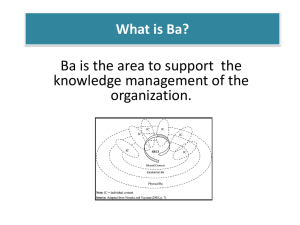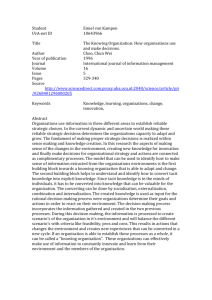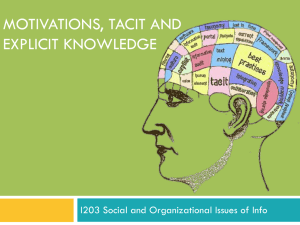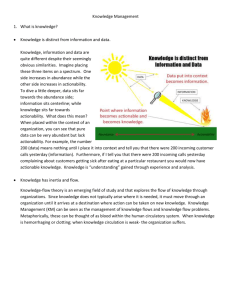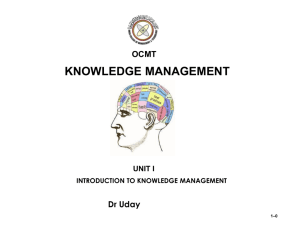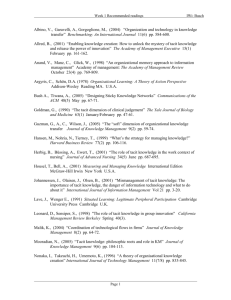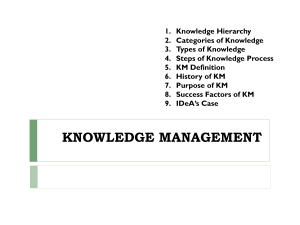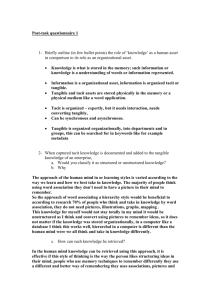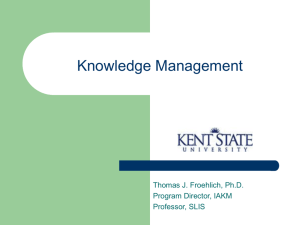KM overview
advertisement
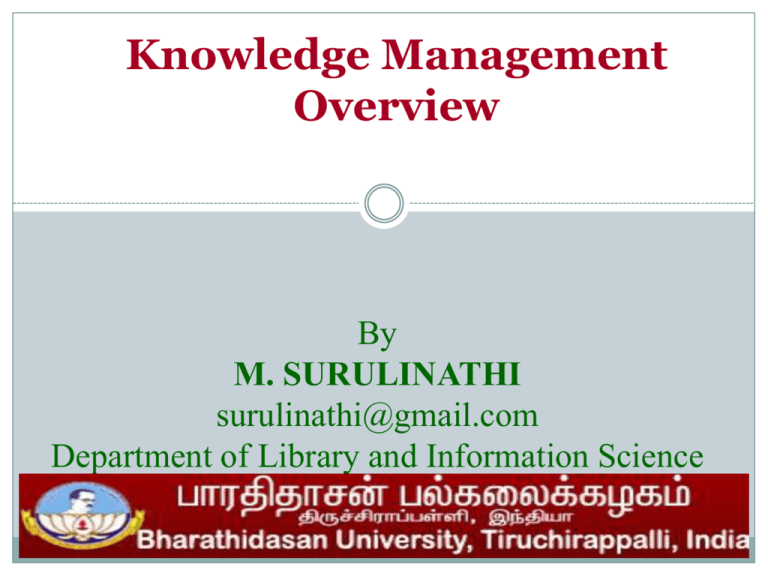
Knowledge Management Overview By M. SURULINATHI surulinathi@gmail.com Department of Library and Information Science What is Knowledge Management? Knowledge Management is planning, designing, building, operating and maintaining the knowledge Management System. Knowledge Management is managing knowledge of · Information in Document (Sounds, Images and Text) Knowledge in People Heads -Collaboration -Storytelling -Mind mapping Organizational Memory -Knowledge Re-use -Community of Practice -Lesson Learning Conversion of Information to Knowledge -Logical intelligence -Collaborative Intelligence -Sensory Experience -Intuition and Technology Experience Learning Methods -Discovery Learning -Constructivist Learning -Task-based Learning -Goal-based Learning Definition of Knowledge Management According to Ouitas et al. (1997) Knowledge Management is to discover, develop, utilize, deliver and absorb knowledge inside and outside the organization through an appropriate management process to meet current and future needs Types of Knowledge Explicit Knowledge Tacit Knowledge Explicit knowledge: Codified Transmittable through formal, systematic language Theoretical Easily transmitted and stored: Documents Databases etc. Approximately 5% of all knowledge Tacit knowledge Personal Experience “Knowledge of body” Mental models Difficult to share and transmit Estimate: 95% of all knowledge Dimensions of Knowledge TACIT KNOWLEDGE EXPLICIT KNOWLEDGE Difficult to teachable · Difficult to articulated · Difficult to observable in use · Complex · Undocumented Teachable Articulate Observable in use Simple Documented Stages in Knowledge Management System Identify Knowledge Knowledge Gap Core Competencies Knowledge Domain People and skills Stages in Knowledge Management System Collect Knowledge Buying Knowledge – Recruiting Merging the Organisations Outsourcing Rending Knowledge – Consultant Data entry OCR and scanning Searching for information to include Stages in Knowledge Management System Select Knowledge Assess the value of Information Find the insight Store Knowledge Expert System – Storing of expert knowledge Repository Keep and Index the knowledge dynamically Stages in Knowledge Management System Share Knowledge · Selective Dissemination of Information · SECI Model Create Knowledge · SECI Model Apply Knowledge · Perform Support System Problem Solving and Task analysis Knowledge Life cycle Model SECI Model Socialization This process focuses on tacit to tacit knowledge linking. Tacit knowledge goes beyond the boundary and new knowledge is created by using the process of interactions, observing, discussing, analyzing, spending time together or living in same environment. The socialization is also known as converting new knowledge through shared experiences. Organizations gain new knowledge from outside its boundary also like interacting with customers, suppliers and stack holders. This occurs in traditional environments where son learns the technique of wood craft from his father by working with him (rather than from reading from books or manuals). Externalization This process focuses on tacit to explicit knowledge linking. It helps in creating new knowledge as tacit knowledge comes out of its boundary and became collective group knowledge. Combination Combination is a process where knowledge transforms from explicit knowledge to explicit knowledge. Creative use of database to get report, sorting, adding, categorizing are some examples of combination process Internalization By internalization explicit knowledge is created using tacit knowledge and is shared across the organization. When this tacit knowledge is read or practiced by individuals then it broadens the learning spiral of knowledge creation. What is Knowledge Capture A process by which the expert’s thoughts and experiences are captured A knowledge developer collaborates with an expert to convert expertise into a coded program Knowledge Capturing Tools The Interview As a Tool Commonly used in the early stages of tacit knowledge capture The voluntary nature of the interview is important Types of Interviews Structured: Questions and responses are definitive. Used when specific information is sought Semi-structured: Predefined questions are asked but allow expert some freedom in expressing the answers Unstructured: Neither the questions nor their responses specified in advance. Used when exploring an issue Other Tools On Site Observation Brainstorming Online Brainstorming Blackboard Knowledge Codification Converting tacit knowledge knowledge in a usable form to explicit Converting undocumented to documented information Knowledge Codification Tools Knowledge Map Knowledge tree Knowledge Table and so on. Other Knowledge Management Tools Moodle Course Management Software Moodle is designed to help educators create online courses with opportunities for rich interaction. It is bringing together users and developers from all over the world into discussions about using and developing as their platform of choice for internetbased learning. Features Forums Content Managing (Resources) Quizzes with different kinds of questions. Blogs Wikis Database activities Surveys Chat Glossaries Peer assessment Multi-language support (over 60 languages) Mind Mapping Storytelling Storytelling as a valuable Knowledge Management technique for sharing knowledge Benefits of Storytelling Communicate quickly Communicate naturally Communicate clearly Communicate truthfully Communicate collaboratively Communicate accurately Communicate entertainingly Communicate movingly Communicate feelingly Communicate intuitively Community of Practice KM Software- Microsoft Office SharePoint Server To facilitate collaboration, provide content management features, implement business processes, and supply access to information that is essential to organizational goals and processes. http://www.microsoft.com/sharepoint/capabilities/portals/demos.mspx Knowledge Management: Case Study KM at NASA KM at INFOSYS KM at CPRI Groupware Knowledge Management in Libraries Libraries should be developed and maintained an integrated online public access catalogue (OPAC) with both internal and external resources as well as printed and other formats of knowledge. Useful websites and knowledge sources should be regularly searched and selected from the internet Knowledge Management in Libraries Going beyond explicit knowledge, libraries should also develop to capture all that tacit knowledge that is of importance to their users, their organizations, and to the internal operations of libraries. The website of each library should serve as a “portal” for all sources of relevant knowledge and information whether explicit or tacit, whether on site or remote and in all formats. Knowledge Management in Libraries Library Website Knowledge Management in Libraries Create Knowledge Repository Chat with Librarian Web Interaction Services Success Factors of Knowledge Management The success of a KM initiative depends on many factors Leadership ( leaders model the behavior = CoP) Culture – (reward systems ) Structure, roles and responsibilities–(steering committee, a central KM support group etc) Information Technology Infrastructure etc… Knowledge Management In Libraries The role of KM in Libraries will become more and more important along with the development of knowledge economy. It is a new management mode. The following superiority and characteristics are incomparable with conventional management. Information technology is a tool for KM Human resource management in KM User Services in KM Knowledge Resource Management Resource Sharing and Networking Technologies for the knowledge management. Intranet within an organization • Document management systems • Information retrieval systems • Relational and object databases • Electronic publishing • Groupware and work flow systems • Push technologies • Help desk applications • Brain storming applications • Data warehousing and data mining Conclusion In summary, Knowledge Management involves connecting people with people, as well as people with information. They have to transform information and knowledge into action The best knowledge creators are academics.

